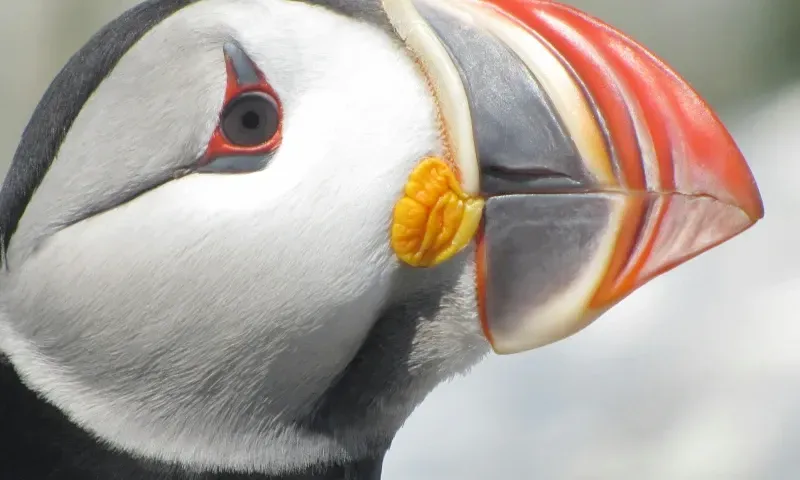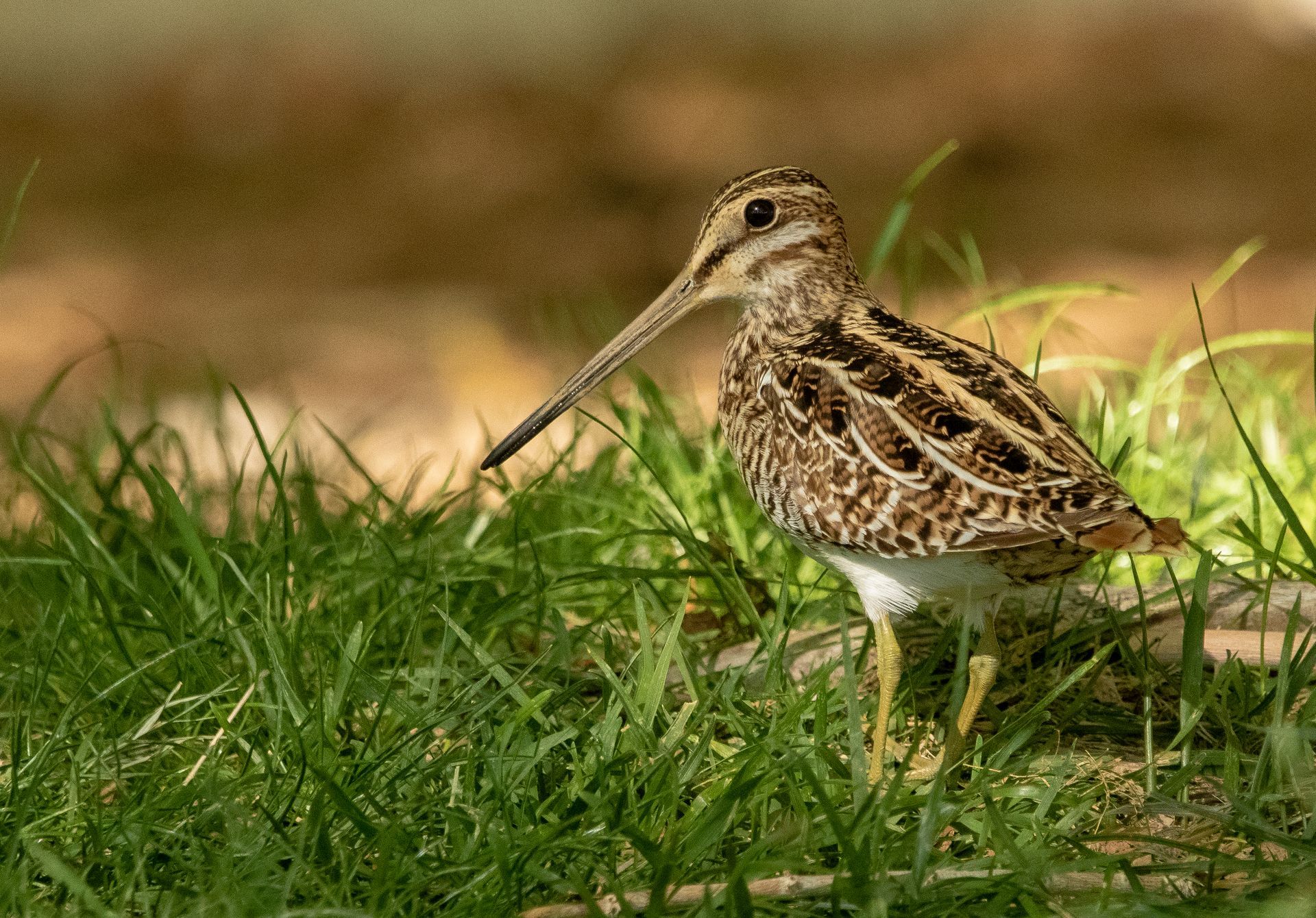PROJECT PUFFIN AND HOG ISLAND AUDUBON CAMP - MORRIGAN DEVITO

In June, I had the opportunity to attend Hog Island’s week-long “Joy of Birding” camp thanks to sponsorship I received from Hog Island and Red Rock Audubon. Directed and led by Holly Merker, co-author of Ornitherapy and whose work as a birding guide focuses on the healing power of birds and nature, we learned about leadership in birding, how birds boost our physical and mental wellbeing, and of course– puffins.
After the first Audubon nature camp was hosted here in 1936, today Hog Island staff and volunteers offer a myriad of programs— from family and teen camps to programs geared towards general birding, fall and spring migration, art, field ornithology, and more. Running concurrently with our “Joy of Birding” was a teen camp, where students from around the country got to see conservation up close with field workshops in bird banding, seabird biology, and many other lifechanging experiences.
If there’s a heaven for birders, Hog Island is it. With a wealth of wonders waiting among the mossy red spruce forests, rocky coastlines, and sea snail-studded tide pools, there is no shortage of things to discover and learn on the island. But Atlantic Puffins continue to take the center stage (or rather, the eight miles east stage), and for good reason, considering they almost went locally extinct.
Yet puffins are not the only birds brought back from the brink in this landscape. Every Osprey and Bald Eagle we spotted during camp was a testament to the conservation work of dedicated biologists, writers, teachers, and community members who spoke out against the use of the pesticide DDT in the 1960s. DDT, which was discovered to cause eggshell thinning in raptors after they ate contaminated prey, caused widespread declines.
Meet Project Puffin
With the exposure of DDT’s harm and the words “environmentalism,” “conservation,” and “sustainability” first entering public consciousness, Atlantic Puffins, in all their clownish glory, waddled their way onto the conservation scene. Stephen Kress, a camp instructor in 1969, read in a book about Maine’s birds that the Atlantic Puffin’s historical range once included Eastern Egg Rock and other small islands in coastal Maine. Local puffins were hunted to extinction because adults and eggs made easy targets, and with that realization, Project Puffin was born.
On my camp’s “puffin watching day”, Eastern Egg Rock was shrouded in a tantalizing fog that coyly lifted for one or two moments before descending over the waves again. But for all the fog’s attempts, we still saw the craggy rocks where Kress and his team diligently hand-reared puffins in sod burrows from 1973 to 1986, the rocks disjointed and multilayered as if the ocean haphazardly stacked the island together. Spread across the small island were observation blinds that biologists sit in for hours on end, and sometimes we saw terns mobbing the biologists on the island as they walked to and from their duties.
And of course there were lots of puffins. Puffins on the rocks, puffins in the air, puffins in the water. Rafts and rafts of puffins paddled, dove, and flew together, and a couple even mated on the waves. All of this to the soundtrack of Common Terns screeching and humans oohing and ahhing at every bird—some others including Arctic Terns, a razorbill, black guillemots, common eiders, laughing gulls, and more.
When Audubon camps used to visit Eastern Egg Rock, students would observe it as a thriving gull colony, filled with plucky Greater Black-Backed and Herring Gulls– no puffins and few terns in sight. And though visitors delight in puffins today, Kress faced plenty of criticism and challenges with bringing them back. For starters, Atlantic Puffins were never endangered in Maine, their northern populations were thriving, and wildlife reintroduction was still nascent at the time— its focus on captive breeding and releasing raptors like Peregrine Falcons back to their former range after DDT was banned in 1972.
Kress and his team relocated the first batch of baby puffins from a colony in Newfoundland, transporting them back to Maine in 1973. Their hard work was only just beginning, and the puffin team worked through triumph and tribulation alike for the next decade. Their trials took the form of heat, rain, hurricanes, mites, a plethora of predatory gulls, and more. Despite the odds, they successfully reared hundreds of relocated puffins every spring in handmade sod burrows, feeding them fish round the clock. But there was a problem. Year after year, adults were not returning to breed on Eastern Egg Rock. Had they died at sea? Were they going to breed on other islands with larger colonies? Had they forsaken Egg Rock?
Enter the Decoys
Every evening after the day’s activities, our camps mingled outside, eating delicious food prepared by the chefs and served by the ever-smiling Friends of Hog Island camp volunteers. Following dinner was a different presentation each evening in “The Fish House”, a cabin/library/meeting room space filled with field guides, natural history books, and even a Gannet that hung from the eaves.
Lined up along one of the shelves were seabird models– brightly painted puffins, oystercatchers, terns, and more posing like colorful toys for bird-inclined children. But these were no toys. They were decoys—because in 1977, the first decoy puffins were crafted and placed as a strategy to lure the puffins back to Eastern Egg Rock. Much like us humans chatting and swapping stories about our day as we waited for the evening’s presentation to begin, seabirds are highly social and vocal in their nesting colonies. When it’s time to breed, they go where the other seabirds are– safer from predators like gulls and raptors, as well as mammals like raccoons and mink.
Enough puffins were fooled by the decoys that they started returning to Eastern Egg Rock, and by 1981 pairs began nesting. This had a ripple effect in bringing other puffins to breed, much to the joy of Kress and his team. And this was all because the puffins were convinced by the decoys, as well as mirror boxes and audio playback of tern vocalizations (which puffins feel safer hearing because terns chase away their gull nemeses) that there was already a thriving puffin colony there. And it wasn’t just puffins that returned. The tern playback was soon joined by tern decoys, and then Common, Arctic, and Roseate terns began nesting as well. Eastern Egg Rock was looking more and more like its historical image.
The decoy method was so successful that it is being used today as a conservation tool globally for endangered and threatened seabirds. Now called the “social attraction method”, this strategy helped Kress and his team expand their puffin rearing and tern-attracting to other islands in the Gulf of Maine. Today, seven islands are home to 100% of Maine’s Roseate Terns, alongside 80% of its Common Terns, and 65% of its Arctic Terns all thanks to the attraction strategies that developed under Project Puffin’s wings.
State of the Seabirds
It’s tough to be a bird, no less a seabird. Many seabirds today are considered “tipping point” species according to the 2022 State of the Birds Report, projected to lose half of their population in the next fifty years if conditions remain the same. Among their challenges include warming oceans, plastics, loss of nesting habitat, overfishing, and more.
“Project Puffin”, renamed the Audubon Seabird Institute to encompass the program’s growing number of projects, has provided us with critical information on the health of our seabirds and oceans. In the Gulf of Maine, Atlantic Puffins are now feeling the effects of climate change, though their population is still rebounding. Their home waters are warming triple than that of the world’s oceans as currents from the arctic (the Labrador Current) and the Atlantic (the Gulf Stream) channel warmer water into the enclosed, “bathtub-shaped” region—meaning the warm water has no exit.
Warmer waters mean less of the puffin’s favorite food: small hake and herring. And unlike humans, who are subjective about the word “favorite”, for puffins this means they’ve evolved to feed their young fish of this size. Any bigger and the babies choke and may die in their burrows, never seeing the waves that call them. Any smaller and they may not get the nutrition they need, setting them up for failure on the unyielding sea. Puffins are the proverbial “canary in the coalmine” for the state of our oceans. And alongside them are other sensitive seabirds like terns, razorbills, guillemots, and more.
A Final Reflection
If Project Puffin teaches us anything, it’s that conservation is a dynamic story. Puffins and other seabirds are facing challenges that Kress and his team may not have imagined. But at the same time, there may be solutions that we have not yet imagined. The more people we connect to nature, the more ideas and conservation we are cultivating.
At camp, I noticed that our conversations had many common threads– how birds have changed our lives for the better, how we help birds in our communities, and our worries and hopes about the future. Above all, whether we were “list birders,” “backyard birders,” “vacation birders,” or something else altogether, many of us came away with ideas we want to bring back to our own community—I heard people say they were going to set up bird feeders at retirement homes, volunteer for their local Audubon chapter, take their grandkids birding, and more.
It’s not so different here in the Red Rock Audubon community. Our history as a chapter is more recent, and our conservation challenges are very different, but it is our love of birds and belief that we can make the world better for birds and people that connects us and all our different skills. It’s one thing to be a birder, but it’s another thing to be a birding leader. Leadership can look as simple as pointing out birds to your friends, or as in-depth as volunteering to lead a birding event.
Regardless of how you share your love of birds with others, as a birding leader you seek to foster people’s experiences of joy and wonder with everyday birds—and that is crucial in conservation, whether you’re looking at desert birds or seabirds. So how can you cultivate those experiences for yourself and others?
If you’re interested in attending Hog Island Audubon Camp, check their camp schedule— there are still some vacancies in 2024’s camps, and 2025 camps will be announced this October. And to learn more in-depth about Project Puffin and some current seabird conservation projects, join my Zoom presentation on July 10!
Further Reading:
Project Puffin by Stephen Kress
Photo Credit: Evon Holladay, unsplash.com
RECENT ARTICLES



